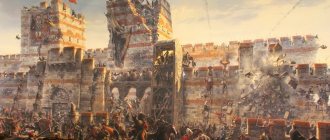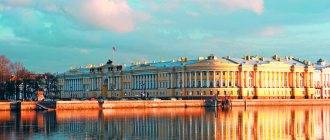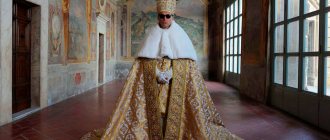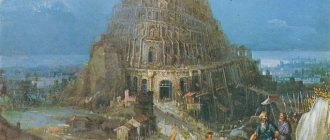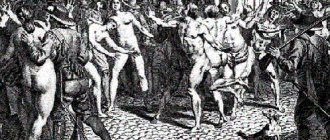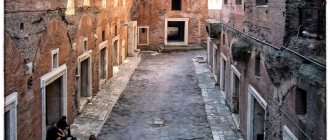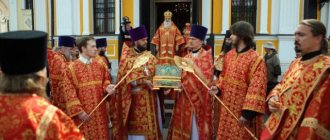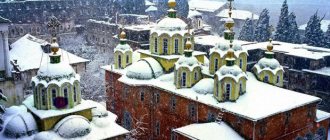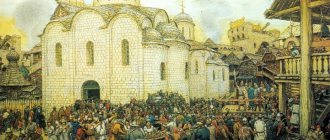The fall of Constantinople is a story filled with pathos. The last emperor of Byzantium rushing into battle to die, a giant bronze cannon shooting half-ton cannonballs, a floating fortress raining down flamethrowers on enemies, the betrayal of Europe, a young empire devouring a decrepit one - it’s hard to imagine something more pathetic.
On April 5, 1453, the Turks brought an army to Constantinople and a siege began, which ended with the fall of the Byzantine Empire and the end of its thousand-year history.
Dying Empire
By the time the Turkish sultan surrounded the city, Byzantium was a miserable remnant of the former powerful empire, and only Constantinople itself and small possessions on the Peloponnesian Peninsula remained in the possession of the emperor. Everything else was already in the hands of the Turks. And the great city itself, with a once million population, was a shadow of its former self - at the time of the siege there were only fifty thousand inhabitants. The ancient stone walls, built a thousand years ago, were already dilapidated and so long that the garrison could not cope with their defense.
The garrison itself at the time of the siege numbered only 7,000 people: 4,983 Greeks and two thousand foreigners - mostly Genoese and Venetians. Things were also very bad with the fleet: 26 ships, of which only 10 were “originally” Byzantine - the pitiful remains of former invincible fleets. Emperor Constantine XI personally headed the defense.
The allies of Byzantium vowed to help in the event of an attack by the Saracens, but only the Genoese mercenaries came, led by Giovanni Longo, who brought 700 men, and the Turkish defector Orhan, led by six hundred warriors. The Venetian captains, who most promised to fight until their last breath for the emperor, fled in the middle of the night, taking away seven of their ships and taking with them 700 Italians.
This is how the once great city appeared before the Turkish army: huge dilapidated walls, some of which the Greeks urgently began to repair, and a population that was barely a twentieth of its former size.
Unlike the Byzantines, the Turks had the opportunity to prepare in detail. Taking into account the previous unsuccessful sieges, their new Sultan Mehmed II, according to various sources, gathered from 100 to 120 thousand soldiers. About twenty percent of them were bashi-bazouks - irregular troops who were paid with the right to plunder. The rest are regular units and Janissaries, that is, the guard of the Sultan himself. The fleet with which the Turks blockaded Constantinople consisted of approximately 36 large and 75 small warships.
Even earlier, the Sultan ordered the construction of the Rumeli-hisary fortress directly opposite Constantinople. Built in just five months, it began to sweep the Bosphorus Strait at its narrowest point, forcing all ships to undergo military inspection, and drowning those who did not want to. This, for example, happened to a Venetian ship that ignored the order of the Turks, was sunk, and the sailors were executed as a warning. The captain of the ship, Antonio Rizzo, was completely impaled - as a warning to other stubborn people.
Prologue of the tragedy
Having ascended the throne in 1451, the first thing Mehmed II did was get rid of his rival: his half-brother Ahmed was drowned in the bathtub. Another rival was Orhan, Mehmed’s second cousin, who lived in Constantinople. The insidious Romans hoped at the right moment, with the help of Orhan, to unleash a civil war for the Ottoman throne. An attempt to get money from the Sultan in exchange for a promise to keep his brother in the Byzantine capital and not to incite unrest resulted in the wrath of Mehmed II. It became finally clear that the city must certainly be taken. Since August 1452, the Sultan and the Emperor were actually at war.
A year before the siege, by order of Mehmed II, the Ottomans began construction of the Rumelian fortress on the European side of the Bosphorus, exactly opposite the Anatolian fortress of his grandfather Bayezid I. Both strongholds were supposed to cut off Constantinople from grain supplies from the Black Sea. The new fortress of Rumelihisar, built in a record four and a half months for that time, was nicknamed “cutting the throat.” It became impossible to pass the Bosporus in this narrowest place without the permission of the Turks and payment of a fee to them. And since the Dardanelles Strait had long been under the control of the Ottomans, Constantinople found itself under blockade from the sea.
Constantinople. Source: pinterest. ca
The search for help and allies in the West was unsuccessful: the Venetians and Genoese secretly concluded commercial treaties with the Ottomans in case the city fell, and the Roman Pontiff tried in vain to call on European monarchs to fight the Muslim invaders. The unification of the western and eastern churches, which the Turks so feared, did not happen: the Orthodox townspeople did not recognize the Union of Florence, officially adopted by Byzantium on December 12, 1452 under the dome of Hagia Sophia.
In January 1453, at the request of the Podestà of Galata, officially neutral Genoa provided real assistance: 2 galleons, 400 soldiers, supplies and various equipment. The expedition was led by condottiere Giovanni Giustiniani, who was soon appointed commander of the defense of the city walls. The Catalans sent a number of troops. A small detachment of Venetians took over that part of the wall that covered Blachernae and their own quarter. Prince Orhan and his retinue also came to the defense of Constantinople. The responsibility of providing the defenders with the famous “Greek fire” fell on the Scotsman. Among the commanders were relatives of the emperor Theophilus Palaiologos and Nikephoros Palaiologos, the Byzantine aristocrat Demetrius Kantakouzin, Metropolitan of Kiev and All Rus' Isidore. The fleet was led by the Venetian commander Alvisio Diedo.
Before the siege began, Mehmed II proposed to the emperor to surrender the city and go to the Peloponnese as sovereign ruler; The townspeople were guaranteed the preservation of life and property. Constantine XI refused to capitulate.
The colossal artillery of the Turks
In this aspect, the Byzantines were completely inferior to the more technologically advanced Turks. In Constantinople itself there were few cannons, and in practice it suddenly became clear that the dilapidated walls and towers were not intended for the use of artillery and when fired, it caused almost more damage to its walls than the enemy.
The Turks were superior to the Byzantines by an order of magnitude. In addition to the numerous siege park, the Sultan invited the Hungarian (and according to other sources, German) master Urban, who, by order of Mehmed, cast him several giant bombards, the largest of which was called “Basilica”. This bronze monster, according to various sources, reached a length of eight to twelve meters, weighed 32 tons and threw half-ton cannonballs at a distance of up to two kilometers. It was delivered to the place of use by thirty pairs of bulls and two hundred people, and was served by up to seven hundred workers.
“Basilica” fired about once an hour, and fired so that the walls were often destroyed from the first hit. True, cracks appeared on it already on the second day, and after six weeks it completely fell apart, unable to withstand use. And Master Urban himself ended his days badly. According to one version, he died when one of his cannons exploded when fired; according to another, after the capture of the city, Mehmed learned that the cunning master first came to the emperor and offered him his services, and when they did not agree on a price, he ran over to the Sultan. Mehmed angrily executed the hapless businessman.
1762–1796
Catherine II
Frustrated bear. French caricature. XIX century © Bibliothèque nationale de France
During the Russian-Turkish War of 1768–1774, Catherine II limited herself only to plans to provide Russia with reliable access to the Black Sea. However, in order to gain the support of the Orthodox peoples of the Balkans, the empress conveyed through her military leaders that the war was being waged to liberate them from the Ottoman yoke.
This could not but have an effect on the Greek patriots, who flocked in thousands under the Russian banner; this also encouraged the local intellectual elite. The scientist and clergyman Eugene Bulgaris, invited by Catherine to Russia, in July 1771, at an audience at court, directly expressed regret that she was not the Greek empress: “Greece, after God, looks at you, prays to you, falls to you.” Later he came out with his program for the fate of the Eastern Question. Bulgaris called on Russia to defeat the Turks: “...The division of the Turkish provinces in Europe, together with the creation of a small independent Principality of the Greek Nation, could help in the future to maintain a real European balance.”
Beginning of the siege and the floating fortress
Starting on April 6, the Turks completely blocked the city and fired at the walls, which the Greeks hastily repaired. Periodically, the Ottomans conducted reconnaissance in force, and their fleet tried to enter the Golden Horn. However, the prudent Greeks blocked it with a giant chain, stretching from the tower on one bank to the tower on the other through special rafts guarded by the remaining ships.
Unexpectedly for both sides, on April 20, three Genoese and one Byzantine ship arrived, carrying weapons, reinforcements and food to the besieged city. The Sultan was furious and ordered them to be destroyed at all costs. He himself was so nervous that he rode his horse into the sea to better see how the battle was going on.
And the battle on the water did not go according to the Turks’ plan. The Genoese ships were higher and could unrequitedly shower the enemy with a hail of arrows and darts, and the Byzantine ship also burned the enemy with Greek fire. In addition, the wind prevented the Turks from quickly approaching closely. When he finally changed and they rushed to board, it turned out that the sides of the Turkish galleys were so lower that they had to climb as if they were climbing a fortress wall. It was not difficult for the Genoese sailors to fight back, chopping off the heads and hands of their enemies with huge axes.
In the end, the Europeans tied all four of their ships together and, thus creating a floating fortress, defended themselves against the advancing Turks until a fair wind appeared. With his help, they reached the chain, where the allied Byzantine fleet was already waiting for them, which covered their entrance to the Golden Horn.
After such a failure, the Turkish admiral Baltoglu was deprived of all his privileges and titles and beaten with sticks on his heels, like some kind of slave.
1547–1584
Ivan IV
Ivan groznyj. Late 16th - early 17th century © National Gallery of Denmark, Copenhagen
Having accepted the title of Tsar as the legal heir of the Greek emperors, Ivan the Terrible did not even think of laying claim to the Byzantine Empire itself. Of the rights of the rulers of Constantinople, he learned only one thing - the right to be considered a representative and defender of universal Orthodoxy. The Moscow tsars did not think about the role of liberators of Orthodox peoples from the Turkish yoke. Ivan IV, informing the Patriarch of Constantinople about the capture of Kazan and Astrakhan, writes to him: “We wish that you too would receive mercy from God, like a cup full of dissolution, and be delivered in these days from the torment of the blasphemous, and we, having heard about this, will rejoice and Let us bring a victory song to God for the glory and honor of His name.”
However, already in the 16th century, Russian rulers began to be pushed into the role of liberators from Turkish rule by the conquered Orthodox peoples themselves. The Patriarch of Constantinople, approving the royal wedding of Ivan Vasilyevich, at the same time in his letter calls him “the hope and hope of all Christian families, whom he will save from barbaric burdens and bitter work”; writes that he and the entire council pray to God to strengthen his kingdom and lift up his hand, “to deliver all Christian families everywhere from the vile barbarians, raw food eaters and terrible pagan Hagarians.”
The Sultan's retaliatory move and the capture of the Golden Horn
A small naval victory brought relief to the residents of the city, but they did not have to rejoice for long. Just a few days later, on April 22, the Turks dragged 70 ships overland into the Golden Horn Bay. They did this using primitive wheeled carts.
The maneuver made it possible to completely blockade the city. After that, all that remained was to prepare for the assault. The Ottomans built large rafts in the bay, on which they placed cannons to constantly bombard the walls. Also, after some time, they built a pontoon bridge from wine barrels tied in pairs. The Turks transferred their troops across this bridge, and now an assault could be expected from this side. Forced to cover this area as well, the few defenders' troops were stretched even further.
As if a new threat were not enough, hostility began among the city’s defenders. The Venetians proposed attacking the Turks, who had broken through to the Golden Horn, with all their might, but at the same time sending the Genoese to hell. The Genoese found out about this and harbored a grudge.
The senseless and stupid conflict lasted six days. By the time everyone calmed down and moved forward to fight back, rumors of the attack had long since reached the Turks and the attackers were met with reinforcements and artillery fire from the shore. The attack failed, and the Turks executed the prisoners in front of the entire city, to which the Byzantines dragged all the captured Turkish soldiers onto the walls and also beheaded them.
March of Last Hope and Mine War
On the third of May, the desperate Byzantines send a small ship flying Turkish flags straight through the enemy fleet for reconnaissance. It was a desperate attempt to find the Venetian fleet, which the Republic had vowed to send to the aid of the besieged.
After some time, the sailors returned with bad news - they found no one. At the same time, a quarrel arose between them, since some offered to sail to Venice, but the majority chose to keep their word and return to certain death.
Meanwhile, the Turks began to use other siege tactics. For example, on May 18, they created a huge tower, covered it with camel and buffalo skins and tried to fill the ditch under its cover. But at night one of the Greeks managed to place a keg of gunpowder under the tower and it shattered into pieces.
In parallel with this, the Turks dug tunnels under the walls, while distracting the Greeks with attacks on the chain in the Golden Horn and constant playing of a huge number of musical instruments. This did not really help and the Byzantines still discovered the tunnels. They sank some of them, blew up some, killing many Turkish and Serbian sappers.
The Emperor's Last Stand
Nevertheless, everything was heading towards its inevitable bloody outcome. The strength of the defenders was running out, morale was gradually falling, and after bad omens the state of the besieged was completely close to panic.
Mehmed II
And then the night of May 29 came. By order of the Sultan, bashi-bazouks and Hungarian, German and Italian mercenaries rushed to the attack. Two hours later, when they had exhausted the Greeks, regular Turkish troops entered the battle, storming the exhausted defenders until dawn. They threw all their strength at the walls and repelled the attacks, using both a few firearms and Greek fire.
Almost at dawn, the “Basilica” destroys part of the wall with one shot and the Turks rush there, but are driven back again. And then the Sultan brings into battle the last reserve - the Janissaries. Two columns of the best warriors of the Ottoman Empire on foot silently go on the attack. Mehmed II himself leads them, escorting them to the ditch.
The bloodiest part of the assault begins, and at this time Giovanni Longo, who, along with the emperor, led the defense, was seriously wounded. The Genoese carry the commander out of the battle, and this becomes a signal for the retreat of all mercenaries, because they understand that the battle is lost.
The Turks intensify their onslaught and then the Sultan’s banner flies over the tower, which is important for defense. It turned out that two hours earlier some stray squad of bashi-bazouks had discovered a secret door in the tower through which the Genoese made sorties. And either they forgot to lock it, or the enemies were able to break it down, but in the end they easily occupied the tower and raised the Turkish flag on it. The emperor, seeing this, tore off all his regalia and rushed into the most brutal part of the battle, where he died. They identified him much later by the eagles embroidered on his boots, cut off his head and hung it up for everyone to see.
How the Turks took Constantinople
Agony of Byzantium
Already at the time of the birth of the Ottoman Sultan Mehmed II, the conqueror of Constantinople, the entire territory of Byzantium was limited only to Constantinople and its environs. The country was in agony, or rather, as historian Natalya Basovskaya correctly put it, it was always in agony. The entire history of Byzantium, with the exception of the first centuries after the formation of the state, is an ongoing series of dynastic civil strife, which was aggravated by attacks from external enemies who tried to seize the “Golden Bridge” between Europe and Asia. But things got worse after 1204, when the crusaders, who had once again set off for the Holy Land, decided to stop in Constantinople. After that defeat, the city was able to rise and even unite some lands around itself, but the residents did not learn from their mistakes. The struggle for power flared up again in the country. By the beginning of the 15th century, most of the nobility secretly adhered to the Turkish orientation. Palamism, which was characterized by a contemplative and detached attitude towards the world, was popular among the Romans at that time. Supporters of this teaching lived by prayer and were as distant as possible from what was happening.
The Union of Florence, which declared the primacy of the Roman Pontiff over all Orthodox patriarchs, looks truly tragic against this background. Its acceptance meant the complete dependence of the Orthodox Church on the Catholic Church, and its refusal led to the fall of the Byzantine Empire, the last pillar of the Roman world.
Last of the Komnenos line
Mehmed II the conqueror became not only the conqueror of Constantinople, but also its patron. He preserved Christian churches, rebuilding them into mosques, and established connections with representatives of the clergy. To some extent, we can say that he loved Constantinople; under him, the city began to experience its new, this time Muslim, heyday. In addition, Mehmed II himself positioned himself not so much as an invader, but as a successor to the Byzantine emperors. He even called himself “Kaiser-i-Rum” - ruler of the Romans. Allegedly, he was the last of the line of the once overthrown imperial dynasty of the Komnenos. His ancestor, according to legend, emigrated to Anatolia, where he converted to Islam and married a Seljuk princess. Most likely this was just a legend that justified the conquest, but not without reason - Mehmed II was born on the European side, in Andrianople. Actually, Mehmed had a very dubious pedigree. He was the fourth son of the harem, from his concubine Huma Khatun. He had zero chance of power. Nevertheless, he managed to become a sultan; now all that remained was to legitimize his origin. The conquest of Constantinople forever secured his status as a great legitimate ruler.
Monument to the last emperor of Byzantium - Constantine Palaiologos 9/2/1404-29/05/1453 in Athens
Constantine's insolence
Constantine XI himself, the Emperor of Constantinople, was to blame for the deterioration of relations between the Byzantines and the Turks. Taking advantage of the difficulties that the Sultan had to face in 1451 - the rebellions of the rulers of the unconquered emirates and unrest in the troops of his own Janissaries - Constantine decided to show his parity in front of Mehmed. He sent envoys to him with a complaint that the sums promised for the maintenance of Prince Orhan, a hostage at the court of Constantinople, had not yet been paid.
Prince Orhan was the last living contender to succeed Mehmed to the throne. The ambassadors needed to carefully remind the Sultan of this. When the embassy reached the Sultan - probably in Bursa - Khalil Pasha, who received it, was embarrassed and angry. He had already studied his master well enough to imagine what his reaction would be to such insolence. However, Mehmed himself limited himself to coldly promising them to consider this issue upon returning to Adrianople. He was not affected by the insulting and empty demands of the Byzantines. Now he had an excuse to break his oath not to invade Byzantine territory.
Mehmed's lethal guns
The fate of Constantinople was not determined by the rage of the Ottoman soldiers, whose influxes the city fought off for two whole months, despite a clear superiority in numbers. Mehmed had another ace up his sleeve. Three months before the siege, he received a formidable weapon from the German engineer Urban, which “pierced any walls.” It is known that the length of the cannon was about 27 feet, the thickness of the barrel wall was 8 inches, and the diameter of the muzzle was 2.5 feet. The cannon could fire cannonballs weighing about thirteen hundredweight over a distance of about one and a half miles. The cannon was pulled to the walls of Constantinople by 30 pairs of bulls, and another 200 people supported it in a stable position. On April 5, on the eve of the battle, Mehmed pitched his tent right in front of the walls of Constantinople. In accordance with Islamic law, he sent a message to the emperor in which he promised to spare the lives of all his subjects if the city was immediately surrendered. In case of refusal, the residents could no longer expect mercy. Mehmed received no response. Early on the morning of Friday, April 6, Urban's cannon fired.
Signs of doom
On May 23, the Byzantines managed to taste victory for the last time: they captured the Turks who were digging tunnels. But it was on May 23 that the last hopes of the residents collapsed. By the evening of that day, they saw a ship quickly approaching the city from the Sea of Marmara, pursued by Turkish ships. He managed to escape pursuit; under cover of darkness, the chain blocking the entrance to the Golden Horn was opened, allowing the ship into the bay. At first they thought it was a ship from the rescue fleet of the Western Allies. But it was a brigantine that twenty days ago set out in search of the Venetian fleet promised to the city. She went around all the islands of the Aegean Sea, but never found a single Venetian ship; Moreover, no one even saw them there. When the sailors told the emperor their sad news, he thanked them and began to cry. From now on, the city could only rely on its divine patrons. The forces were too unequal - seven thousand defenders against the hundred thousandth army of the Sultan. But even in faith the last Byzantines could not find consolation. I remembered the prediction of the death of the empire. The first Christian emperor was Constantine, son of Helen; so will the last one. There was another thing: Constantinople will never fall as long as the moon shines in the sky. But on May 24, on the night of the full moon, a total lunar eclipse occurred. We turned to the last protector - the icon of the Mother of God. She was placed on a stretcher and carried through the streets of the city. However, during this procession, the icon fell from the stretcher. When the procession resumed again, a thunderstorm with hail broke out over the city. And the next night, according to sources, Hagia Sophia was illuminated by some strange radiance of unknown origin. He was noticed in both camps. The next day the general assault on the city began.
Omen
The morale of the besieged fell after the return of the ship on the 23rd, which found no help. Everyone knew about the predictions that the last emperor, like the first, would bear the name Constantine and be the son of Helen. There was also a prediction that Constantinople would not fall on the waxing moon. But on May 24 there was a full moon and then the moon should have waned, a lunar eclipse superimposed on this. The frightened residents of the city decided to go through a religious procession the next day, but the icon fell and could not be raised, then a downpour poured in, giving way to dense fog, and at night a glow was noticed around the dome of St. Sophia. Nicolo Barbaro wrote: it happened. On the other hand, this sign seemed to the Turks a sign of victory, who were very happy and held a great celebration in their camp.”
Last days The morale of the Ottoman army also weakened over time. The Ottomans feared the arrival of Christian reinforcements, especially since János Hunyadi claimed to be free from the peace treaty signed with the Sultan. In addition, the Ottoman fleet suffered several setbacks. Mehmed again tried to achieve the surrender of the city. Around May 25, he sent an envoy to the city, Isfendiyaroglu Kizil Ahmed Bey. S. Runciman considered the goal of the negotiations to convince the Byzantines to surrender the city in exchange for an unhindered exit from the city with all their property to everyone and immunity for the remaining residents, and for Constantine - power in the Morea. According to F. Babinger, Mehmed suggested that Constantine convert to Islam for salvation. However, the emperor agreed to a huge ransom for lifting the siege and payment of an annual tribute of 70,000 ducats in the future, to all conditions, and made all concessions, except one - the surrender of Constantinople. In response, Mehmed II demanded an unprecedented ransom and an annual tribute of 100 thousand gold Byzantines, which the city could not pay. At the same time, as F. Babinger believed, following Chalcocondyl, the real goal of these negotiations was not the surrender of the city. Mehmed needed his man to penetrate the city and inform him about the situation inside the walls.
On May 26, Mehmed gathered his advisers to listen to their opinions. From the very beginning, Khalil Pasha was against the conflict with Christians and the siege of the city, which, in his opinion, only brought losses to the empire, and now the army risked facing the arrival of Western reinforcements. The idea that Khalil Pasha received gifts from the Byzantines was not loudly voiced, but from that time on the vizier fell out of favor with the Sultan. Zaganos Pasha, like many other younger military leaders, spoke out in favor of continuing the siege. According to George Sfrandzi, Zaganos Pasha argued that Constantinople had nowhere to expect real help, because among “Italian and other Western rulers... there is no unanimity. And if, nevertheless, some of them, with difficulty and numerous reservations, came to a consensus, then soon their union would lose strength: after all, even those of them who are bound by an alliance are busy stealing what belongs to another - each other lie in wait and beware." These words indicate that the Sultan and senior dignitaries were well versed in the foreign policy situation. Mehmed supported those of his assistants who insisted on continuing the siege. Preparations for a major attack were accelerated, trench material was brought in, guns were placed on new platforms, and the intensity of the bombardment of the walls in the Mesotechion area increased on 26 and 27 May. On the same day, Mehmed's envoys announced to the troops the final assault on the city and motivated them with a promise to plunder the conquered city within three days. All day on May 27, the troops dug in the ditch, and at midnight the work was suspended, as the Sultan declared Monday, May 28, a day of rest and preparation for the final assault.
Capture of the Golden Horn Bay. Prophecy fulfilled
Cannonballs rained down on the city. The Turkish fleet blocked Constantinople from the sea. But there still remained the inner harbor of the Golden Horn, the entrance to which was blocked, and where the Byzantine fleet was located. The Turks could not enter there, and the Byzantine ships even managed to win the battle with the huge Turkish fleet. Then Mehmed ordered the ships to be dragged overland and launched into the Golden Horn. As they were being dragged, the Sultan ordered all the sails to be raised on them, the rowers to wave their oars, and the musicians to play fearsome melodies. Thus, another ancient prophecy came true, that the city would fall if sea ships sailed on land.
Unknown Venetian artist con. XV - beginning XVI century Ottoman, as well as Genoese, Venetian, Cretan and Byzantine ships are visible. Ottoman flags flutter over the Golden Gate and Kerkoporta, and there are clouds of smoke over the city.
The Ottomans' final preparations
Mehmed made a general inspection tour. He ordered his entire fleet in the Golden Horn and the Sea of Marmara to prepare for an assault, with sailors attempting to scale the sea walls of Constantinople to force the besieged to disperse their forces and keep someone at every point on the wall. Zaganos was supposed to provide assistance to the sailors, while the rest of the Ottoman troops concentrated in the area of the walls of Blachernae. To his right, up to the Charisius Gate, the beylerbey Karaca Pasha was in charge of the advance, while Ishak Pasha and Mahmud Pasha led the Anatolian forces for the assault between the Gate of Saint Roman and the Sea of Marmara. The Sultan took control of the Lykos Valley sector, the weakest point of the Byzantine defense.[131] The Sultan also met with representatives of Pera and demanded not to provide any assistance to the besieged city under threat of punishment. In a speech to his commanders and viziers, he pointed out that the city was not invincible, and that the defenders were exhausted, few in number and inconsistent.[131] “For the rest of the day, from dawn until night, the Turks did nothing except bring very long ladders to the walls for use on the next day, which was to be the climax of the attack. There were about two thousand of these ladders, and after that they erected many obstacles to protect the people who had to lift the ladders to the walls.”
Preparations in Constantinople In the city, they immediately learned about the Ottomans’ decision to launch a decisive assault, since the Christians who were in the Turkish army informed the besieged about this through notes tied to arrows and thrown over the city walls. It was clear to the residents and authorities of Constantinople that the final hour of the siege was near. But even in these last hours there was no unity between the defenders. The conflict between the Genoese and Venetians intensified. The Venetians again accused the Genoese of Pera's neutrality and betrayal. Leonard described how, while preparing for the final assault, Giustiniani and Luca Notaras argued over where to place the artillery. Giustiniani assumed that the main blow would be taken by the walls and towers in the Lykos Valley, and Notaras intended to strengthen the defense of the walls along the Golden Horn. The conflict had to be resolved by the emperor, who took the side of Giustiniani[132][133][134]. Another conflict was the conflict between the Italians, who participated in the defense of the city mainly voluntarily, and the local residents, the Greeks[134]. The Italians accused the Greeks of greed:
“On this day, we Christians made seven carts with mantels to install them on the land walls. When these mantlets were made, they were brought to the square, and the bailo ordered the Greeks to immediately take them to the walls. But the Greeks refused to do this unless they were paid, and that evening there was a dispute because we Venetians were willing to pay cash to those who carried them, and the Greeks were not willing to pay. When the mantelpieces were finally carried to the walls, it was dark and they could not be placed on the walls for attack, and we did not use them because of the greed of the Greeks."[78] On May 28, the last repairs to the walls were made. On Monday, May 28, icons were carried along the streets in the city, a religious procession was held with the singing of “Have Mercy on Us,” in which everyone who was not currently on duty or involved in repairing fortifications, regardless of religion, participated. The relics were taken to the weakest points of the walls, and Constantine made a final speech to all the defenders[135]. Later he went to the castle in Blachernae, where he said goodbye to his family members. The emperor then prayed in the Church of St. Sophia, and at midnight he left, accompanied by Sfrandzi, for a final inspection of the walls, after which they returned to Blachernae and watched the Ottoman preparations from a tower on the most protruding part of the wall at the Caligarian Gate. At about one o'clock in the morning the emperor released his secretary[136].
In the evening the defenders returned to their positions. Giustiniani and his men stood at the weakest point of the Mesotychion wall. The doors on the inner wall were closed to prevent retreat.
Storming the walls of Constantinople by Philippe de Mazerolles[fr], 1450-1475.
The Siege: The Final Assault By the time of the final assault, the walls of Constantinople had been seriously weakened, and Ottoman artillery had made three breaches. The first is between the Adrianople Gate and the Palace of the Porphyrogenites, the second is near the Gate of St. Romanos in the Lykos Valley, and the third is near the Third Military Gate. But the gap in the Lykos Valley was the largest.
Lauro Quirini[it] wrote a letter to Pope Nicholas V on July 15 from Crete and described the final assault as three waves. Barbaro also wrote about three stages: “The Sultan divided his army into three groups of fifty thousand people each: one group consisted of Christians who were kept in his camp against his will, the second group consisted of people from dysfunctional families, peasants, etc. . p., and the third group consisted of the Janissaries.”
First wave: beginning
On the night of May 28-29, at about half past one in the morning, Ottoman troops along the entire line launched an assault through the gaps. The last Christian service in the Church of St. Sophia was still ongoing when the last attack on the city began. In the Ottoman army, drums, trumpets and flutes made a loud, deafening noise. The alarm was raised in Constantinople and everyone capable of bearing arms took their places on the walls and at the breaches. The Ottomans filled the ditch in front of the walls, and the besieged could not stop them. Several thousand irregular soldiers, with shouts, drums and trumpets, attacked the walls of Constantinople in order to wear down the defenders. In their ranks were Ottomans, Slavs, Hungarians, Germans and Italians with ladders. Behind these unreliable soldiers, Mehmed placed a defensive line of Janissaries. The Ottoman losses were very heavy. The Ottomans' efforts were concentrated in the Lykos Valley area. Their attack was threatening only in this place; in other places they were easily repulsed. In the area of Lykos, the defense was led by Giustiniani Longo, and all the arquebuses and cannons that were in the city were also concentrated here.
The attacking Ottoman troops suffered huge losses and many soldiers were ready to turn back to escape the devastating fire from the walls.
The historian Duca wrote that the Sultan himself, personally “standing behind the army with an iron stick, drove his soldiers to the walls, where he flattered with merciful words, where – threatening.”
According to Chalkokondylus, the punishment for the timid warrior was immediate death.
According to pseudo-Sfrandzi, “the chaushis and palace ravdukhs (military police officers in the Turkish army) began to beat them with iron sticks and whips so that they would not show their backs to the enemy. Who can describe the screams, screams and sorrowful groans of the beaten!”
Nestor Iskander also claimed that the Ottoman commanders forced the soldiers to attack by beating.
After a two-hour battle, the Ottoman commanders gave the command to retreat. The Greeks began to restore temporary barriers in the gaps.
The second wave Mehmed ordered a retreat, and sent the Anatolian troops of Ishak Pasha to attack the gap at the Third Military Gate (Triton). Fighting in a narrow space gave an advantage to the defenders; a large number of attackers hindered them. Orban's cannon destroyed the palisade, which allowed three hundred attackers to penetrate inside the walls, but Constantine's detachment managed to push them out. In other areas of the defense, the defenders also managed to repel attacks.
From the southern wall, a detachment of soldiers went to help the defenders of the Lykos Valley, the monks and Orhan's detachment repelled several attacks from the Sea of Marmara. At the wall of the Golden Horn, the Ottomans were unable to really threaten the Byzantine defenses. The attacks of the Zaganos detachment on the Blachernae Palace were repulsed by the Venetians, and the attacks of Karadzhi Pasha were repulsed by the Bocchiardi brothers.
Third wave: Giustiniani wounded. Kerkoporta
Kerkoporta After the withdrawal of Ishak Pasha's Anatolian troops, a barrage of shells fell on the walls, followed by a third attack. It was led by 3,000 Janissaries, whom Sultan Mehmed himself brought to the fortress moat and sent to attack. The Janissaries advanced in two columns. One stormed the Blachernae wall, the second went to break in the Lykos area. Despite fatigue, the defenders managed to repel this attack. According to Barbaro, the besieged felt that victory was possible when an Ottoman flag appeared on one of the towers.
It is not known exactly how the Ottomans entered the city. Niccola della Tuccia wrote about the Florentine Neri, who lived for 36 years in Constantinople and enjoyed the trust of the emperor. According to Niccolò, Neri was entrusted with the keys to the gate, and it was Neri who opened the gate for the Ottomans during the final assault. The Genoese, noticing the Ottoman flag, rushed towards it. At this moment, an event occurred that is considered to be the turning point of the final assault and the key moment of the siege - at the gate of St. Romano, Giustiniani was wounded in the chest by a bullet or crossbow arrow (in the arm or thigh). Saad ed-Din described it this way: The leader of the outright scoundrels who fought with our heroes mounted the ramparts to repel the champions of religion, A brave, agile youth climbed the castle wall like a spider, and, drawing his crooked saber, with one blow forced him to the owl's soul to fly out of the unclean nest of his body.
Giovanni Giustiniani LONGO (1418 - 1453)
Giustiniani’s first wound: “Zustunei with his entire squad and all the fryags began to restore the tower; and a stone cannonball flew out of the cannon at the end and hit Zustunei in the chest; he fell to the ground, and as soon as the tide ebbed, they carried him into the house.” The wounded Giustiniani sent one of his soldiers to Constantin Dragash to ask him for the key to the small gate and get it inside the city. The Emperor refused this request because before the attack it was decided that after the soldiers entered Peribolos, the gate behind them would be locked. Nevertheless, Giustiniani's soldiers brought the commander to the city without listening to Constantine. The Venetians accused Giustiniani of cowardice and called him the culprit of the defeat. Barbaro did not even mention Giustiniani's injury and simply stated that Giustiniani had deserted:
“Seeing this, Zuan Zustinian, a Genoese from Genoa, decided to leave his post and fled to his ship, which was standing at the pier. <...> and when he fled, he passed through the city shouting: “The Turks have entered the city!” But he was lying, because the Turks were not yet inside. When the people heard the words of their captain that the Turks had entered the city, they all fled, and they all immediately abandoned their posts and rushed to the harbor in the hope of escaping in ships and galleys.” Since then, Giustiniani’s act has been causing debate. It is argued that if he had remained with the detachment at post, Constantinople might have been saved.
Nestor Iskander claimed that Giustiniani was wounded twice. On the eve of the last assault or at the very beginning, “a stone ball from a cannon flew in and, falling, hit Zustuneya in the chest and broke his chest. And he fell to the ground as soon as they poured water on him and carried him to his house.” After being shot in the chest, he was "treated all night" but never recovered. The second time, “they threw a spear and hit Zustuneya, and wounded him in the right shoulder, and he fell to the ground as if dead.” In addition to Nestor Iskander, Giustiniani’s double wound was mentioned by Nikolaos Sekundinos, who ended up in Constantinople after the siege (with the Venetian envoy Bartolomeo Marcello) to negotiate the ransom of the captured Venetians. Secundinos wrote: "Giovanni [Giustiniani] ... began to lose hope of saving the city and was wounded twice." Nikolaos received information from survivors of the siege in Constantinople. The second wound caused severe pain. This is valuable information explaining Giustiniani's departure from the walls.
Sources described Giustiniani's wound in different ways: with an arrow in the right leg; in the chest with a crossbow shot; a lead bullet pierced his arm and damaged his breastplate; he is wounded in the shoulder from a culverin; he was struck by one of his own. According to R. Crowley, who adheres to the opinion of two wounds, it seems most likely that in the second wound his armor was pierced by a lead bullet, but the small hole concealed severe damage.
Estimated location of Kerkoporta: the junction of the 96th tower (left) and the Palace of Constantine Porphyrogenitus
The Venetians and Greeks, led by Emperor Constantine, were left alone. Constantine tried to stop the Ottoman breakthrough himself, without the Genoese, he sent his last reserves to the gate, but it was too late. The emperor galloped back into the Lykos valley to the gate through which Giustiniani had entered the city and tried to organize a defense, but the defenders were already retreating. Further, in some accounts there appears a mention of a certain Janissary Hasan, who, at the head of a detachment of 30 people, was able to break into the passage. Half of them and Hassan himself were killed, but the rest gained a foothold. Janissary Hasan is not mentioned in the descriptions of contemporaries. His name appears for the first time in the “Chronicle of Magis” (Psefdo-Sphrantzi), which is a 16th-century falsification by M. Melissourgos-Melissenos:
“A certain Janissary named Hassan (and this giant came from Lupadia), holding a shield above his head with his left hand, and holding a sword in his right, climbed onto the wall - to where he saw our confusion. He was followed by about thirty others who competed with him in courage. Ours, who remained on the wall, hit them with spears, hit them with arrows and rolled huge stones onto them, so that eighteen of them were driven away from the wall. But Hassan decided not to stop the onslaught until he climbed the walls and put our people to flight. <…> a lot of Turks were killed. During this battle, Hasan also fell from the wall, struck by some kind of stone. Our people, turning to him and seeing him lying, began throwing stones at him from all sides. Rising to his knee, he defended himself, but from many wounds he lowered his right hand and was bombarded with arrows.”
The final assault on Constantinople
The last defenders were gradually driven towards the inner rampart, where they died in large numbers in the ditch from Ottoman shells. According to Barbaro, “at sunrise the Turks entered the city near San Romano, where there had previously been walls, leveling them with their cannon.”
Duka described the events a little differently. According to him, Giustiniani’s departure was not critical; after Giustiniani’s departure, the defenders, led by Constantine, repelled the Ottoman attack at the gates of St. Roman. But at the junction of the walls of Theodosius and Blachernae, in the sector defended by the Bocchiardi brothers, the defenders used a small gate called Kerkoporta (Circus Gate) for night attacks against the Ottomans. Supposedly, someone had forgotten to lock them, this was quickly discovered by a detachment of about 50 Janissaries who entered the city and attacked the besieged from the rear. Ducas is the only chronicler to report this. S. Runciman adhered to Duca's version and wrote that the Kerkoport port was closed, it was opened for a sortie and left open by mistake, which the besiegers took advantage of.
Death of Constantine Massacre in Constantinople. From the book by J. Sagredo and P. Rico. 1694 One way or another, the Ottomans broke through the walls of the great city - through Kerkoporta, another gate, or through a breach in the wall. This immediately led to the collapse of the defense of Constantinople, since, due to their small numbers, the defenders did not have the reserves to eliminate this breakthrough. More and more crowds of attacking Janissaries came to the aid of those who had broken through; the Romans did not have the strength to cope with the pressure of the enemy. According to the traditional version (stated by S. Runciman and F. Babinger), the emperor, having heard about the enemy’s breakthrough through the harbor and realizing that the city could not be saved, threw off all the signs of imperial dignity, except for his boots, and rushed into battle. This version is based on the description of Kritovul, according to which the last words of the emperor were: “The city has fallen, I have no reason to live anymore.” In the thick of the battle, Konstantin was struck by two blows - in the back and face.
Massacre in Constantinople. From the book by J. Sagredo and P. Rico. 1694
According to Babinger, after the city was captured on Mehmed's orders, the battle site was searched and a body with purple shoes was discovered, which was recognized as Constantine. The emperor's severed head was placed on the Column of Augustus and then sent "in a precious casket from one Muslim ruler to another." The burial place of the body is unknown. According to Babinger, at the end of the 16th century, the Greeks lit candles in memory of Constantine at one tomb in Vefa Square, but the Ottomans erased all traces of the tomb, “and only a lonely trunk of an old willow tree in the corner of the courtyard pointed to the abandoned final resting place of the emperor - a weather-beaten stone.” .
The fate of the city's defenders
Entry of Mehmed II into Constantinople. J.-J. Benjamin-Constant
Giustiniani arrived in Chios on a Genoese ship and died of his wounds in early June. Despite the fact that it was only thanks to him that the city lasted so long, many Venetians, Romans and even some Genoese (for example, Archbishop Leonard) believed that he turned out to be a coward and a deserter. The Bocchiardi brothers fought after the Ottomans broke through into the city, but realized that it was useless and began to try to break through to the ships. Paolo was captured and executed (or wounded and killed), and Antonio and Troilo were able to sneak onto a Genoese ship and took refuge in Pera. The Venetians, led by bailo Minotto, were practically surrounded in Blachernae. Paolo, the bailo's son, died, like many others. Minotto and his second son Zorzi, along with other members of the nobility, were left alive for ransom. The Sultan later ordered the execution of Minotto along with his son and six other military leaders.
29 Venetians were later ransomed. The Catalans fought to the end. Some of them, along with the consul Pere Julia, were captured and later executed. Filippo Contarini and Dimitri Cantacuzene found themselves trapped after the Ottoman breakthrough. During the breakout attempt, most of them were killed, and Demetrius Cantacuzene, Philip Contarini and some noble warriors were captured. Shehzade Orkhan and his entourage resisted the attackers to the last. Orhan tried to hide under the guise of a monk, speaking Greek, but was captured and recognized. His severed head was presented to the Sultan. Jacopo Tetaldi managed to escape. He was able to reach the shore two hours after the Ottomans broke through into the city. He tore off his clothes, threw himself into the water and swam to the ships, where he was lifted aboard one of them. He made it in time at the last moment - looking back, he noticed that those walking behind him had managed to be captured. Some escaped on the other side of the Golden Horn. The Podesta of Galata wrote: “At great risk I led them into a settlement near the palisade; you have never seen anything more terrible.” Responsible for the defense in the Acropolis area, Cardinal Isidore concluded that the city had fallen and that there was no need to die in vain, so he tried to save himself by exchanging clothes with a beggar. The beggar was captured and executed in the cardinal's place, and his head was placed on a stake. Isidore himself was also captured, but as a beggar; a merchant from Pera recognized him, did not give him up and bought him for little money, and then released him for a ransom.
The sailors from Crete, who valiantly defended the towers of Vasily, Lev and Alexei and refused to surrender, were able to leave unhindered. Admired by their courage, Mehmed II allowed them to leave and by the beginning of June they arrived in Crete on three ships. The commander of the fleet, the Venetian Diedo, with whom Nicolo Barbaro was, sailed to Peru after the Ottoman breakthrough and asked the Podesta to give his opinion on whether the Genoese ships that were fighting should continue the fight in the Golden Horn or flee. Lomellino said that he would send an envoy to the Sultan to ask whether he would allow the ships to leave or start a war with Genoa and Venice. Diedo decided there was no time to wait and tried to return to his ship, but the gates to Pera were closed. He decided that they had been betrayed; he and his retinue barely managed to return to the ship. They swam to the chain and unfastened it with axes, after which the Christian ships began to leave the Golden Horn. At the mouth of the bay, the ships stood for some time to pick up refugees leaving the city by swimming, then a small squadron headed for the Italian colonies in the Aegean Sea. One of the districts of Istanbul became known as the Pushkar Verban District. Presumably, Orban settled there. Podesta Lomellino's nephew, Imperiale, who fought in the last battle as a volunteer, was captured. Lomellino himself wrote that his traces were lost, but Soderini reported on August 30 that Imperiale had been converted to Islam. He later received a position and served the Sultan. Gabriel Trevisano assessed the situation too late, was unable to descend from the walls in time and was captured by the Turks.
On May 30, the Sultan ordered all the treasures and prisoners to be delivered to him. Having chosen his share of the booty and determining which part belonged to those who were deprived of the opportunity to participate in the robbery, he approached the prisoners. He chose the most beautiful girls and boys for his harem, but freed most of the noblewomen and gave them funds so that they could ransom their relatives, while he invited the young men to convert to Islam and serve in his army, which some accepted, but most refused. Among the captives, Luka Notaras and nine other ministers of Constantin Dragaš were recognized, but not Sfrandzi. The Sultan ransomed and released them, but they were all very soon executed one way or another on various charges, because Mehmed wanted to behead the Greek community. Sphranzi himself later managed to ransom himself and his wife, but not his children, after which he left Constantinople and went to Western Europe, where he completed his Chronicle.
Three days of looting
Rome's successor, Constantinople fell on May 29, 1453. Then Mehmed II gave his terrible order, which is usually forgotten in stories about the history of Istanbul. He allowed his large army to plunder the city with impunity for three days. Wild crowds poured into the defeated Constantinople in search of booty and pleasure. At first, they could not believe that the resistance had already stopped, and they killed everyone who came across them on the streets, without distinguishing men, women and children. Rivers of blood flowed from the steep hills of Petra and stained the waters of the Golden Horn. The soldiers grabbed everything that glittered, stripping vestments from icons and precious bindings from books and destroying the icons and books themselves, as well as breaking out pieces of mosaics and marble from the walls. Thus, the Church of the Savior in Chora was plundered, as a result of which the already mentioned, most revered icon of Byzantium, the Mother of God Hodegetria, which, according to legend, was painted by the Apostle Luke himself, perished.
Some residents were caught during a prayer service in the Hagia Sophia. The oldest and weakest parishioners were killed on the spot, the rest were captured. The Greek historian Ducas, a contemporary of the events, talks about what is happening in his work: “Who will tell about the crying and screams of children, about the screams and tears of mothers, about the sobs of fathers, who will tell? Then the slave was mated to the mistress, the master to the slave, the archimandrite to the gatekeeper, gentle young men to maidens. If anyone resisted, he was killed without mercy; each, having taken his captive to a safe place, returned for the booty a second and third time.” When the Sultan and his court left Constantinople on July 21, the city was half destroyed and blackened by fires. Churches were looted, houses were devastated. Driving through the streets, the Sultan shed tears: “What a city we gave up to robbery and destruction.”
Fall of Constantinople
The Turks burst through the walls, opened the gates, and the conquerors poured into the ancient city, bringing fire, destruction and death. For two days the city was plundered, and on the third, Sultan Mehmed II, henceforth called the “Conqueror,” stopped the looting with an iron fist, marking a new stage in the life of Constantinople.
From now on, this thousand-year-old city will be called Istanbul, the capital of the Ottoman Empire. Another page of history was turned, and the chroniclers of those years wrote with bitterness (or vice versa, joy): on May 29, 1453, Constantinople fell, Byzantium disappeared forever from the face of the Earth.
